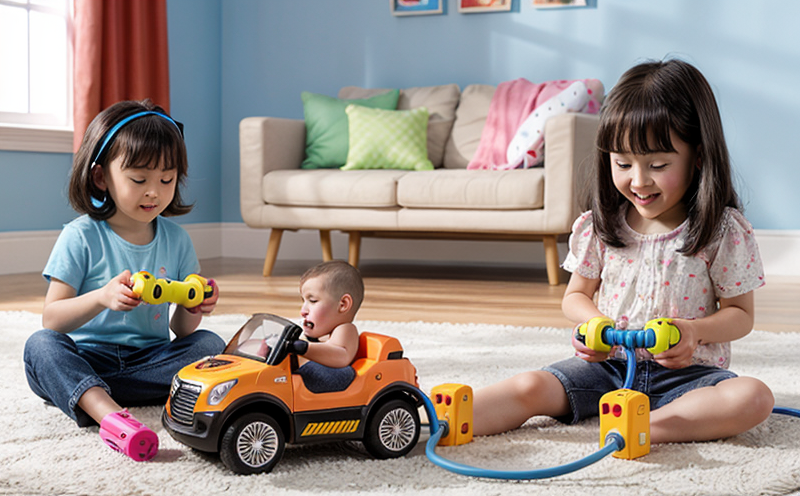IEC 62115 Humidity and Condensation Resistance Test
The IEC 62115 standard is a crucial guideline for ensuring the safety, durability, and performance of electrical and battery-operated toys. This test specifically evaluates whether such toys can withstand humidity and condensation without compromising their functionality or posing risks to users. Conducted in controlled environments that simulate real-world conditions, this test ensures that toys remain operational under adverse environmental conditions.
The IEC 62115 standard covers a wide range of toy products including but not limited to electronic toys, remote-controlled toys, and any product with integrated batteries or electrical components. The primary objective is to ensure the safety of children by preventing potential hazards such as electric shock, fire risks, and material deterioration.
The testing process involves subjecting the toy specimens to a controlled humidity chamber where they are exposed to varying levels of humidity over extended periods. This exposure simulates the conditions that toys might encounter during storage or use in different climates. The test evaluates whether the toy maintains its electrical performance, mechanical integrity, and safety features throughout the exposure.
During the testing process, it is critical that proper specimen preparation is followed to ensure accurate results. This includes cleaning the specimens thoroughly to remove any external contaminants which could interfere with the test outcome. The specimens are then mounted in a suitable holder designed for the specific type of toy being tested. Once prepared, the specimens undergo exposure to controlled humidity levels and temperature variations.
The use of appropriate instrumentation is essential for accurately measuring the conditions within the chamber and monitoring the performance of the toys during testing. This includes high-precision temperature sensors, humidity meters, and specialized equipment capable of simulating real-world environmental stressors. The data collected from these instruments provides detailed insights into how each toy performs under varying levels of humidity.
The acceptance criteria for passing this test are stringent and are based on international standards including IEC 62115 itself as well as other relevant guidelines such as ISO/IEC 80079-34. A toy passes the test if it maintains its electrical continuity, does not exhibit any signs of corrosion or deterioration in appearance or functionality after exposure to the specified humidity levels and durations.
The results from this testing are highly valuable for manufacturers as they provide critical information about the durability and reliability of their products under adverse conditions. These insights enable manufacturers to make necessary adjustments to improve product design and ensure compliance with safety regulations. Additionally, passing this test enhances brand reputation by demonstrating commitment to quality assurance practices.
- Ensures long-term performance of toys in humid environments
- Reduces the risk of product failures due to corrosion or other environmental factors
- Increases consumer confidence and satisfaction with toy products
- Facilitates compliance with international safety standards for electrical & battery-operated toys
Benefits
The IEC 62115 Humidity and Condensation Resistance Test offers numerous benefits to toy manufacturers, quality managers, compliance officers, and R&D engineers. By undergoing this rigorous testing process, companies can ensure that their products meet the highest safety standards while maintaining optimal performance across diverse environments.
One of the key advantages is enhanced product reliability. Manufacturers gain valuable data on how their toys behave under various humidity levels, allowing them to identify potential issues early in the development cycle and implement corrective measures promptly. This reduces the likelihood of recalls or returns after products have already reached market, thereby saving significant costs associated with post-launch fixes.
Another significant benefit lies in improved compliance with international safety regulations. Adhering strictly to IEC 62115 ensures that all aspects of toy design and manufacturing align perfectly with recognized industry benchmarks. This not only simplifies the regulatory approval process but also opens up new markets where stringent quality standards are enforced.
For R&D engineers involved in designing innovative toys, this test provides essential feedback on material choices, component integration strategies, and overall system robustness. It helps guide future iterations towards more resilient designs capable of enduring harsher conditions without compromising user experience or safety.
In summary, implementing the IEC 62115 Humidity and Condensation Resistance Test offers tangible advantages that contribute to better product quality, increased market access, reduced operational risks, and strengthened brand reputation. These factors collectively enhance customer satisfaction and loyalty, fostering long-term success for toy manufacturers.
Industry Applications
- Educational toys that may be stored in damp conditions during transport or use by children with varying levels of physical activity.
- Battery-operated remote control vehicles which might operate outdoors where humidity is prevalent.
- Puzzles and games featuring electronic components that could experience condensation inside enclosed spaces like backpacks or storage boxes.
Competitive Advantage and Market Impact
By incorporating the IEC 62115 Humidity and Condensation Resistance Test into their quality assurance protocols, toy manufacturers gain a significant competitive edge in today's highly regulated and increasingly globalized market. Meeting these stringent standards demonstrates a commitment to delivering safe, reliable products that meet or exceed customer expectations.
Compliance with this standard also facilitates easier access to international markets where strict safety regulations are enforced. This is particularly important for businesses aiming to expand their reach beyond domestic borders into regions like Europe, North America, and Asia-Pacific. The ability to confidently market compliant products worldwide enhances brand credibility and fosters trust among consumers.
Furthermore, the rigorous nature of this testing process encourages continuous improvement in product design and manufacturing processes. Manufacturers who consistently pass such tests tend to innovate more effectively, staying ahead of emerging trends while ensuring consistent quality across all their offerings.





